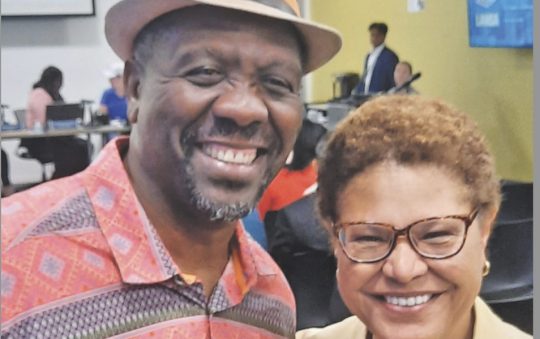
Metro had nearly 24 million bus and train boardings in June, a 13.3% increase from last June that marks the seventh straight month of year-over-year growth, the agency announced on July 25.
“I’m excited that people continue to return to our buses, trains and rideshare services,” L.A. Mayor and Metro Board Chair Karen Bass said in a statement. “With the opening of the Regional Connector last month, Metro has made it more accessible and affordable to travel by public transit across the region, and the benefits of this new connectivity are translating into
increased ridership.”
Bass added she “looks forward to seeing ridership continue to grow” as Metro continues to expand the transit system and improve public safety.
Related Links:
https://lasentinel.net/local-contractor-helps-build-metro-rail-project-thanks-to-cdab-program.html
https://lasentinel.net/metro-extends-street-team-and-community-engagement-program-on-the-k-line.html

Metro’s monthly bus and rail ridership now stands at 81% of its 2019, pre-pandemic level, with average weekend ridership at 91% of pre-pandemic levels and 76% for average weekdays, the agency reported.
In June, Metro recorded 23,824,620 passengers aboard its bus and rail systems, with an average of 866,670 rides each weekday. Saturday and Sunday boardings averaged about 646,743 and 542,727 passengers, respectively. The agency noted that ridership recovery continued to
strengthen on the weekends, with average boardings on Saturdays and Sundays reaching almost 89% and 94% of pre-pandemic levels.
Bus ridership continued to lead overall with 18,679,084 rides during June, with total bus ridership at almost 84% of its level in June 2019.
The agency, alongside the city of Los Angeles, installed more than 30 miles of bus priority lanes, the most recent of which opened on Venice Boulevard in June.
More than 5 million trips were taken on the rail system in June, an increase of 14.2% compared to the same time last year, Metro said. Rail ridership growth was led by gains on the B (Red) and D (Purple) lines. Average weekday ridership on the B and D lines is up 15.5% year-over-year, and up 5.6% since January.
Average ridership on the B and D lines now exceed its level in June 2019, before the pandemic.
According to the agency, weekend ridership was driven by special events including the Pride Parade, Pride Night at Dodger Stadium, Pride in the Park, and CicLAvia South L.A. The opening of the Regional Connector stations in the Little Tokyo/Arts District, Historic Broadway and Grand Avenue Arts/Bunker Hill also generated ridership, with more than 100,000 riding the new A and E lines on opening day.
More than 82,000 people continued to ride the new lines over the opening weekend.
“Metro’s three new downtown stations stitched together the A, L, and E lines, and made getting around Los Angeles easier and more fun,” Metro CEO Stephanie Wiggins said in a statement.
“Our riders can now easily visit downtown restaurants and events, and travel through three beautiful art filled stations which are quickly becoming destinations themselves.”
In a statement, the agency also highlighted various “proactive” steps taken recently aimed to “ensure its transit service is safe, friendly, fast, and frequent.” They include:
— a new “multi-layered” public safety approach “to increase the
visible presence of both armed and unarmed security and customer care personnel
on the system”;
— a Drug-Free Metro campaign focused on drug-related crimes and
targeting “hotspots throughout the system”;
— engaging more than 300 Metro Ambassadors to help customers navigate
the system;
— hiring more than 1,000 new transit operators, and
— fully restoring bus service.
Metro also stressed its fareless and reduced-price transit pass programs, such as its GoPass program for K-12 and community college students, and its Low-Income Fare is Easy program that provides free rides and discounted fares to people with low incomes.






